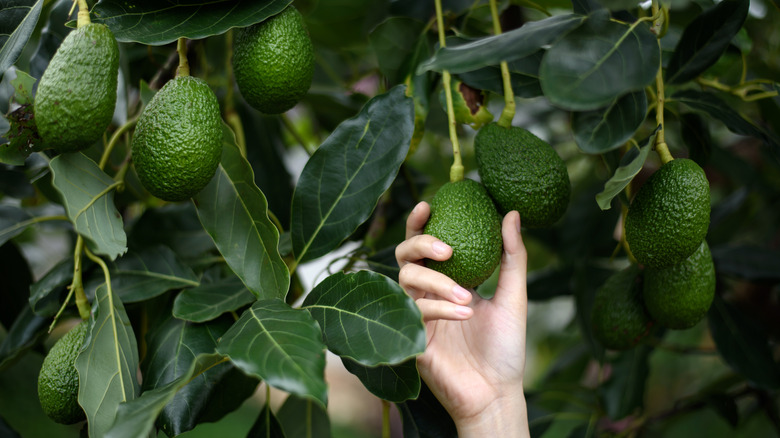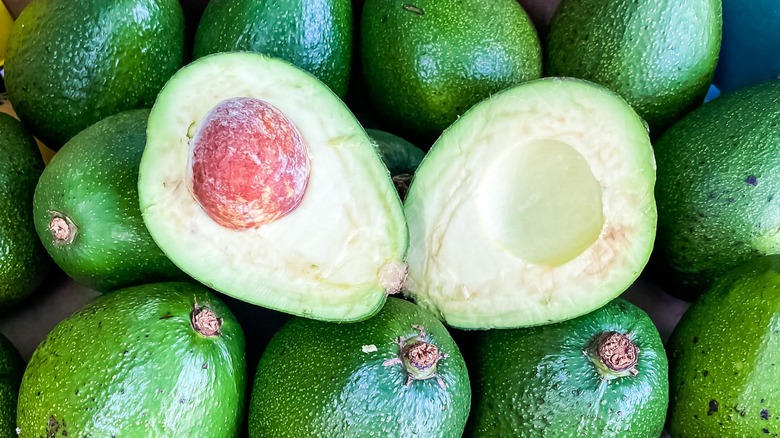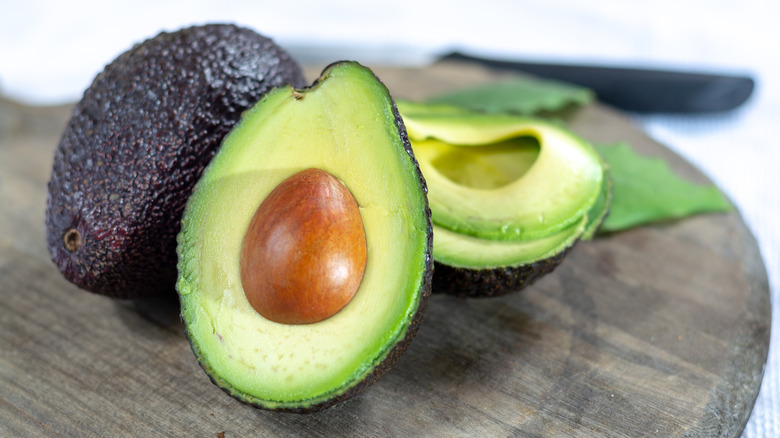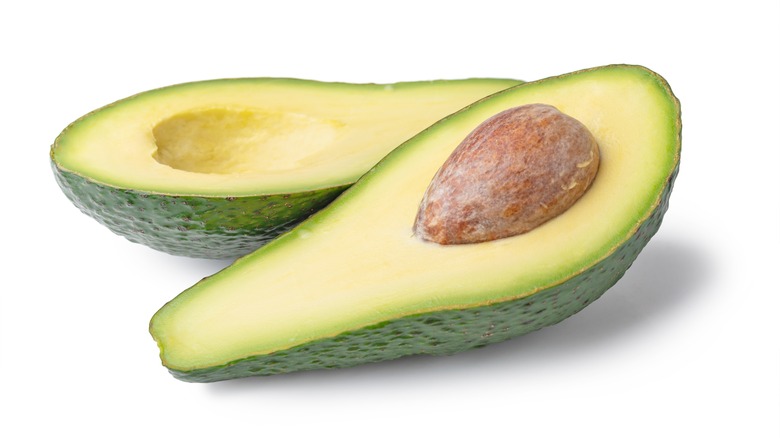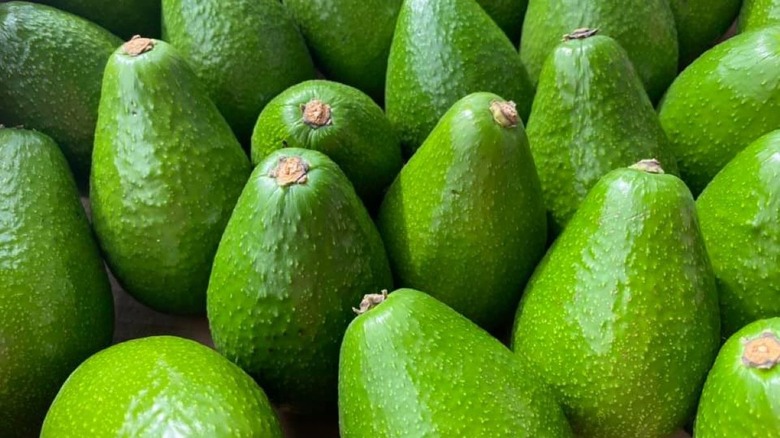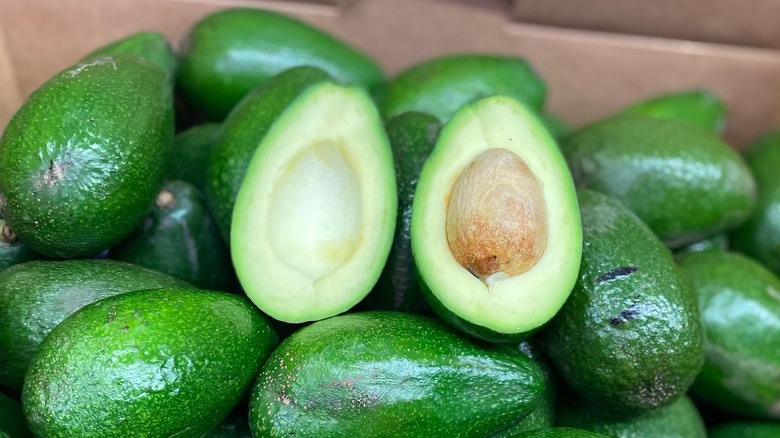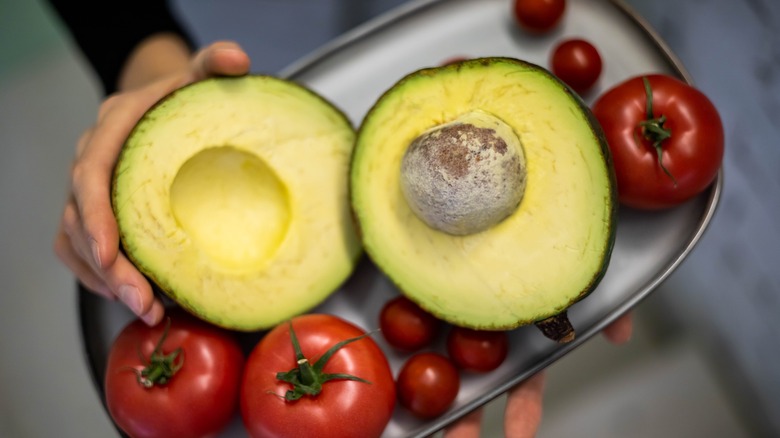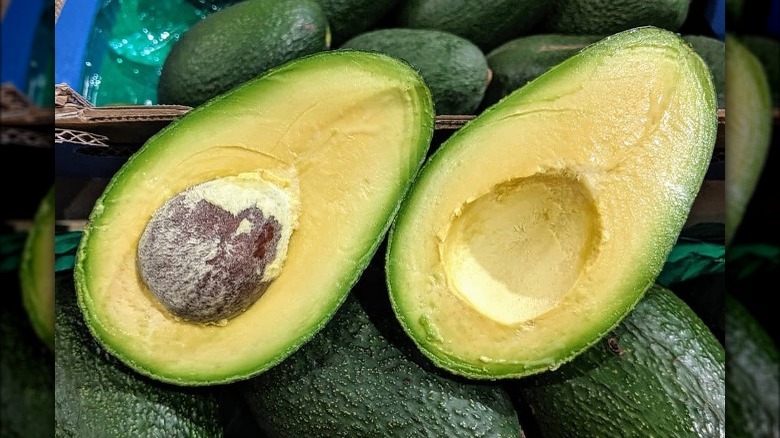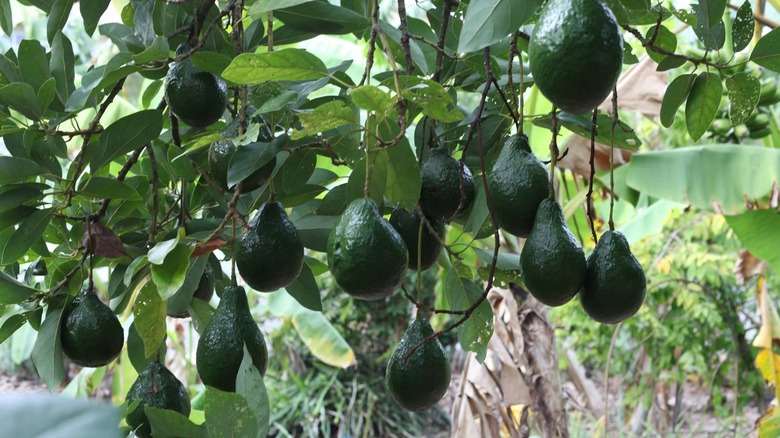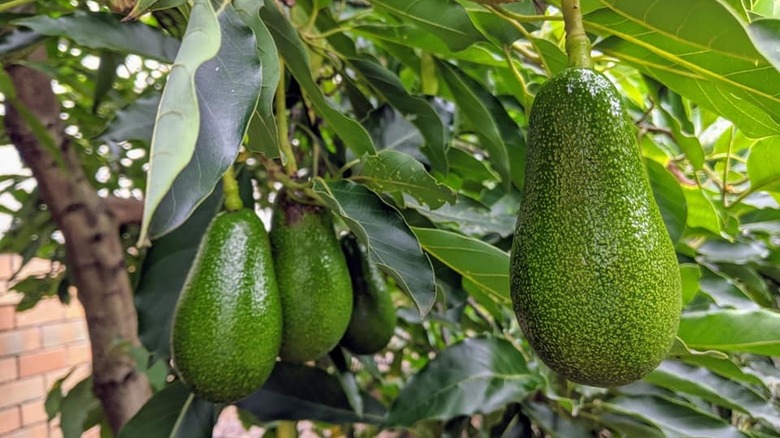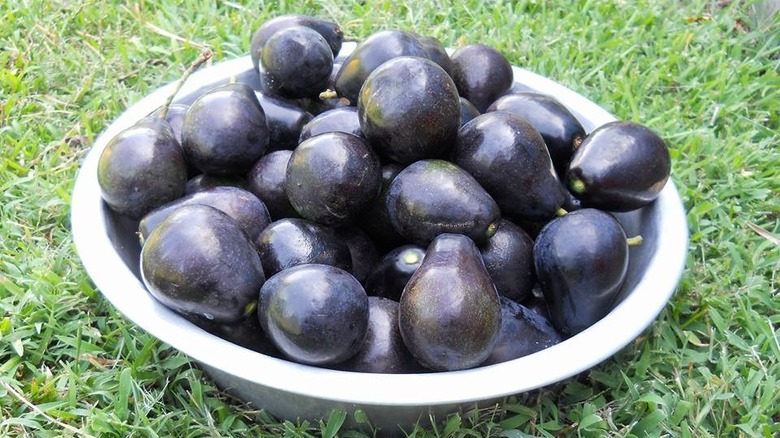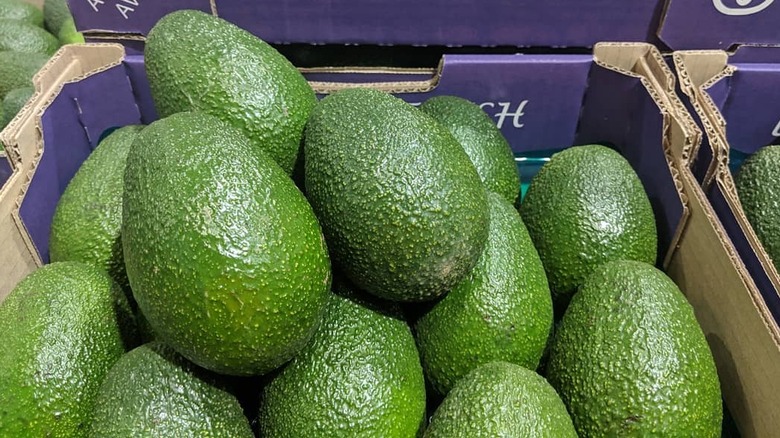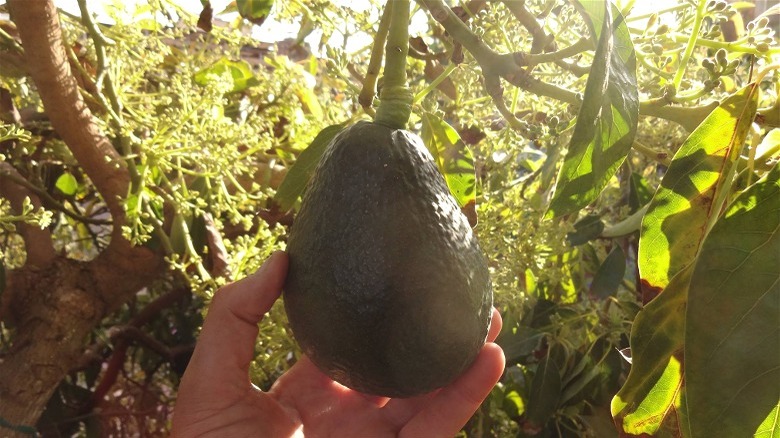12 Avocado Varieties You Should Know About
Do you know how many types of avocados exist? Chances are, you've tried the well-known Hass since it accounts for 95% of all avocados consumed in the United States (per Avocados from Mexico). But it's not the only avocado out there. In fact, avocados have been around for more than 10,000 years – today, there are more than 500 known varieties.
All these varieties (or cultivars) have Guatemalan, Mexican, or West Indian roots. And many avocados are hybrids, like Hass, a descendant of Mexican and Guatemalan seedlings. But origins aren't the only distinguishing factor when it comes to these fruits. Avocado trees are separated into categories, type A and type B, based on how their flowers bloom. Type A fruits are often known to have darker skin and oily flesh, while Type B is typically covered in delicate, green skin. Seed size also varies among these, and some retailers have even marketed seedless avocados.
With so many different avocados, you'd expect the produce aisle to reflect this diversity. But instead, Hass is piled high, and other types are harder to find. So why does one avocado dominate the market? And what other varieties are we missing out on? Keep reading to learn more about America's top-selling avocado, along with 11 delicious yet lesser-known varieties.
Fuerte
Before the Hass avocado hit the market, the Fuerte reigned supreme. Fuerte seedlings, along with several other varieties, were transported from Mexico to Los Angeles County in 1911. But when an intense freeze killed most of these trees, batch No. 15 proved resilient. This surviving cultivar was aptly named Fuerte, meaning "strong" in Spanish.
Compared to Hass, Fuertes are bigger — but that doesn't always mean better. It has a sizeable pit which is an obvious con in the avocado world. However, Fuerte's flavor makes up for most of its shortcomings. It has a characteristic nuttiness that consumers love, making it the second most popular avocado in the States (per Homestead and Chill).
Despite its California roots, the Fuerte now grows primarily in Florida. Florida avocados tend to have a lower fat content, giving them the nickname "slimcado." But less oil means they hold up better when sliced, making this avocado fuerte in more ways than one. So if you want those picture-perfect wedges on your toast, opt for this avocado.
Hass
Hass rhymes with mass — not "hoss" which many of us have been pronouncing forever. As of 2012, Hass make up 95% of all avocados grown in the United States (per the University of California Davis). But this wasn't always the case. Hass avocados developed by accident in 1926 when Rudolph Hass, a California mailman and avocado aficionado, started planting any seeds he could find. One of these trees produced a bountiful crop of dark, bumpy fruit. His kids adored the buttery flavor, and the fruit quickly became the family's namesake.
Farmers love Hass trees because they produce a high volume of fruit whose thick skin is ideal for shipping and handling. And consumers love Hass because of its convenient size and rich flavor. Although people initially associated ripe avocados with Fuerte's green color, they jumped on the Hass bandwagon after a clever marketing campaign. Tim Spann, research program director for the California Avocado Commission, said, "This was done by talking about the built-in ripeness indicator — the black peel — and placing stickers on fruit at the point of sale that said, 'Ripe for Tonight'" (via Smithsonian Magazine). With a culture that loves reliability and instant gratification, it's no wonder the Hass quickly rose to fame.
The Hass has become the golden standard of avocados and is what you'll likely find on fancy toast or in guacamole. But if you believe that bigger is better, its descendent, the Lamb Hass, has a comparable flavor but a slightly larger size.
Pinkerton
The Pinkerton brothers discovered this avocado on their California ranch in the 1960s. Based on its features and the nearby crops, they believed it was a hybrid of Rincon and Hass. New fruit varieties pop up all the time, but Pinkerton offered something unique. It has an earlier harvest season than Hass, so farmers could sell this similar-tasting avocado a few months before Hass season started. Not only would they make more money, but they also wouldn't risk over-picking their precious trees.
But Pinkertons aren't just a backup fruit. They have their own distinguishing features that set them apart. Their elongated necks make them one of the easiest avocados to identify, and their pebbly skin turns a deep green when ripe. However, this fruit is slow to ripen, and one might sit on your countertop for two to three weeks before it's ready. Some might see this as a negative, but an extended shelf life can be a good thing. Pinkertons can be shipped long distances, and if you forget one in your fruit bowl on vacation, it'll be ready when you get home.
Although Pinkertons might require patience, they're worth the wait. They have one of the smallest pits of all avocados and an appealing golden-yellow flesh. With a high oil content and satisfying taste, they make an excellent Hass replacement during the colder seasons. So if you're making guacamole in winter, reach for a Pinkerton.
Zutano
Zutano avocados are sold commercially, but not always for the reason you'd think. These trees are known for their cross-pollinating abilities, growing alongside other avocado varieties to produce more robust crops. Zutanos and Hass are a particularly harmonious pairing. Since the popular Hass is a type A, farmers often bring in B trees like Zutanos for a higher yield. And with opposite harvesting seasons, growing Hass and Zutanos on the same plot also ensures year-round production.
As B-flowering fruits, Zutanos differ from your usual Hass or Pinkerton. These trees produce a plentiful wintertime harvest, and once picked, the fruit's skin stays green as it ripens. But don't let its bright exterior fool you. If it's slightly soft, it's ready. And despite its thin skin, this avocado variety is surprisingly easy to peel.
With Zutanos, you don't get that soft avocado flavor — which can be a good thing. Zutano's firm texture means that no matter how you slice them, these avocados retain their shape well. So if you're going for presentation points, Zutano avocados work in your favor. When practicing the art of sushi-making, layer thin avocado strips on top of a roll. These will provide a beautiful burst of green color and crisp flavor without becoming a mushy mess.
Bacon
Bacon might seem like an odd name for an avocado. And although they're both great on burgers, this fruit has nothing to do with the crispy meat. Instead, this avocado gets its name from James Bacon, the first person to plant it on his California farm in 1954.
Mexican avocados are known for being cold-hardy, meaning they can tolerate frost. And as a Mexican hybrid, the Bacon avocado can withstand temperatures as low as 24 degrees Fahrenheit for four-hour periods. While it wouldn't last several days in the snow, it does well in cooler areas like San Francisco.
This cultivar has smooth green skin that's lightly speckled with an occasional dark patch on the bottom. When sliced open, you'll immediately notice its flesh is lighter than most. The pale yellow hue reflects its mildness. It won't add a big bang to your Mexican meals, but it's smooth enough to eat independently. And since peeling the skin is tedious, Bacons are best scooped out with a spoon. Halve the avocado, drizzle some lemon juice or hot sauce, and dig in.
Reed
Reed avocados are large and spherical, resembling a green softball. They don't change color when ripe, so you'll need to gently check that the texture is soft enough to eat. One trick to check an avocado's ripeness is by popping the stem button off and poking a toothpick into the fruit. A smooth entry means a ripe Reed.
When it comes to eatability, Reed avocados don't get the credit they deserve. It's the best variety to eat with a spoon. The flesh naturally separates from the skin, avoiding those gritty or bitter pieces of skin. The shell also functions as a built-in bowl, perfect for stuffing. Dice up the creamy flesh, mix in hummus or tuna, and voila! You've got a satisfying meal with minimal clean-up.
So why aren't Reed avocados more popular? Since Hass shot to fame, people expect ripe avocados to be dark. It's a classic case of being born in the wrong era. Now, if you want to try this lesser-known cultivar, you'll need to hunt it down at a farmer's market or plant one yourself.
Sharwil
Sharwil is another hidden gem. The medium, pear-shaped fruit has a solid flesh-to-seed ratio, resulting in an avocado that's nearly three-quarters meat. But the Sharwil doesn't just boast quantity — it's considered one of the best-tasting avocados on the market. The higher-than-average oil content might be a contributing factor. To put this in perspective, the Sharwil averages 28% oil while Hass has 21%. For many, this results in a depth of flavor that surpasses the top-selling Hass. However, if you don't enjoy avocado's more buttery notes, the Sharwil is probably not for you.
So why hasn't everyone heard of this variety? Well, it doesn't hail from California like most avocados on this list. The name Sharwil combines Sharpe and Wilson, the two Australian farmers that created this cultivar. While it still grows in Australia and New Zealand, it thrives in Hawaii's tropical climate. As such, Sharwil avocados make up most of Hawaii's commercial avocado production and are the only Hawaiin variety that can be shipped to the mainland (via Speciality Produce). Unfortunately, a fruit-fly incident back in 1992 scared the USDA into imposing tight regulations, and nowadays, Sharwill can only be found during colder months in 32 northern states and Washington, D.C. (via U.S. Senate Press Release).
Lula
Lulas are the prettiest avocados at the party. With a slight neck and glossy green skin, there's an elegance to this fruit, and George Cellon would likely agree. This Miami-based horticulturist first planted this variety in the early 1900s, naming it after his wife.
The Lula avocado boasts more than just a pretty face. It's considered cold-hardy and can withstand temperatures as low as 25 degrees Fahrenheit. This, combined with a long harvesting season, make Lula avocados a great addition to any garden.
And when these fruits are ripe, you're in for a real treat. Lula avocados are particularly known to be smooth and creamy. If you haven't tried avocados in dessert, here's your chance. This fruit goes well in everything from sweet smoothies to healthy chocolate pudding. Although it can be hard to shake the idea of avocados solely being savory, try not to limit yourself. Avocados are a fruit, after all, and a versatile one at that. But stick to cold desserts — due to avocados' high lipid content, they can take on a bitter flavor when heated.
Wurtz
Wurtz is also known as "little cado" or "little Hass" because it's the only real dwarf tree of its kind. Since it reaches about 10 feet tall, it's a manageable option for those looking to grow avocados with less land or even indoors.
Despite being a small tree, the Wurtz fruit is comparable in size to the Hass. But with less oil, it feels lighter on the palette. So what's the biggest downside to Wurtz avocados? They have an unpredictable pit size. This might seem like a petty detail, but a seed-to-flesh ratio is crucial when picking the ideal avocado. However, fans are rarely discouraged by this, and the Wurtz is one of the most popular varieties on the market.
What's wonderful about Wurtz avocados is they are the ideal middle ground between soft and firm. The texture is perfect as a burger or sandwich topping. These avocado slices maintain form long enough to bite down but still give you that melt-in-your-mouth sensation. If you prefer your avocados as an accompaniment, it can be added to many no-cook side dishes like fresh dips or ceviche.
Mexicola
Despite its name, the Mexicola avocado was actually born in Pasadena, California in 1910. This fruit is slightly larger than a chicken's egg and has exceptionally dark purple skin. But this tree is truly unique in that it also grows cukes, which are seedless avocados created by improperly pollinated flowers. These long, thin avocados grow alongside regular Mexicola fruits but are sold under the name "Mexicola cocktail avocados."
With a paper-thin, edible skin, you can eat a Mexicola like an apple. Considering its small size, it would be easy to down the whole thing as a snack. However, its exterior has an anise-like flavor, while the meat has more subtle herbal notes. If you're not a fan of anise, it's perfectly acceptable to halve the avocado and just eat the center. However, cooking with a Mexicola might be challenging since they don't peel well, and you'll need several to make a small bowl of guac. They work better as a flavor enhancer or to tame garlic-heavy dishes.
Mexicola trees offer more than just their fruit. While many avocado plants have toxic leaves, Mexicola's foliage is edible and might have medicinal benefits. According to Nature's Produce, chewing on these leaves can support gum health and is used as a natural remedy for diarrhea, sore throat, and hemorrhages.
Gwen
The Gwen avocado was created by Dr. Bob Bergh of UC Riverside and patented by the University of California in 1984. Like the Lula, the Gwen tree was named after the developer's wife. This avocado is a descendant of the Hass, and didn't fall far from the tree. You'll notice the resemblance in its thick, pebbly skin and mouthwatering taste.
Although not as small as a Wurtz, Gwen avocado trees are considered a dwarf variety. They typically cap off at a mere 15 feet but can easily be pruned to keep them even smaller, making them ideal for backyard gardens. Unfortunately, this Californian variety is dying out fast because it's a delicate tree that's sensitive to the elements and requires cross-pollination to thrive.
But when a Gwen tree is happy, it's bursting with flavorful fruits. These avocados maintain their rich green hue when ripe and are nutty, buttery, and easy to peel. Being slightly larger than Hass, there's also more to go around. So if you're looking to feed a family with a similar-tasting fruit, Gwen avocados can help.
Holiday
The Holiday avocado is a relative newcomer on the scene, with the first plant cultivated in 2001. This fruit was given its festive name because it ripens between the Labor Day and New Year celebrations. While it's rarely sold commercially, it makes a great tree for a small-scale garden. Mature Holiday trees can grow up to 16 feet, but they have a tendency to be weeping rather than standing upright.
For such a petite tree, Holidays produce a large quantity of fruit. So when harvesting season comes around, it'll really feel like Christmas. These avocados are big and round and stay green when ripe. Although they're susceptible to stem rot, they aren't very fibrous and are full of flavor.
The flesh is dense but creamy, making an excellent binder in sauces. Since avocados have a similar creaminess and fat content to dairy products, they can be whipped into a mayonnaise or sour cream substitute. But if you're searching for dairy-free condiments, there's no need to get all fancy. Avocados are tasty enough to stand on their own. So rather than top your baked potato with cheese, try diced avocados instead. It's a fuss-free solution that is just as rewarding.
